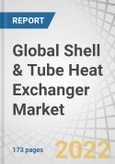The global shell & tube heat exchanger market size is projected to grow from USD 9.0 billion in 2022 to USD 11.7 billion by 2027, at a CAGR of 5.4% between 2022 and 2027. Rising demand from emerging markets and growing industrialization are expected to offer significant growth opportunities to manufacturers of shell & tube heat exchanger.
The petrochemical and oil & gas segment accounted for the second largest CAGR in the shell & tube heat exchanger market in terms of value, during the forecast period
Shell & Tube heat exchangers are used in the petrochemical industry in the manufacturing of alcohols, aromatics, detergents, olefins, varnishes, and plastics & wastewater treatment. The demand of shell & tube heat exchangers in the petrochemical industry varies according to the grades of oil. Some of the major processes utilizing the shell & tube heat exchangers in the petrochemical industry are syngas heater, boiler feedwater heater, and sour gas heater.
Steel is the largest material segment of shell & tube heat exchanger market
Steel is widely used in shell & tube heat exchanger. This material accounted for the largest share of material in the shell & tube heat exchanger market. Stainless steel is ideally used for the construction of shell & tube heat exchanger due to its high strength & durability, and resistance against corrosion. The most preferred steel grades by manufactures are mild steel and stainless steel.
North America is estimated to be the second-largest market for shell & tube heat exchangers
North America is the second-largest market for Shell and tube heat exchangers. The US, Canada, and Mexico are the major countries in the North American market. The region has a strong industrial base. Some of the major players operating in the shell and tube heat exchangers market are based in this region, such as Xylem, API Heat Transfer, Koch Heat Transfer, and Manning & Lewis.
In-depth interviews were conducted with Chief Executive Officers (CEOs), marketing directors, other innovation and technology directors, and executives from various key organizations operating in the shell & tube heat exchangers market, and information was gathered from secondary research to determine and verify the market size of several segments.
- By Company Type: Tier 1 - 40%, Tier 2 - 30%, and Tier 3 - 30%
- By Designation: C Level Executives - 20%, Directors - 10%, and Others - 70%
- By Region: APAC - 50%, Europe - 20%, North America - 10%, the Middle East & Africa - 10%, and South America - 10%
The key players in this market are Alfa Laval AB (Sweden), HRS Heat Exchangers (UK), Kelvion (Germany), Xylem (US), API Heat Transfer (US), Koch Heat Transfer (US), Thermex (UK), Manning and Lewis (US), Thermofin (Canada), and Mersen (France).
Research Coverage:
The report offers insights into the Shell & tube heat exchanger market in key regions. It aims at estimating the size of the shell & tube heat exchanger market during the forecast period and projects future growth of the market across various segments based on material, application, and region. The report also includes an in-depth competitive analysis of the key players in the shell & tube heat exchanger market, along with company profiles, MNM view, recent developments, and key market strategies.
Key Benefits of Buying the Report
From an insight perspective, this research report focuses on various levels of analysis - industry analysis (industry trends), market share ranking of top players, and company profiles, which together comprise and discuss the basic views on the competitive landscape; emerging and high-growth segments of the shell & tube heat exchanger; high growth regions; and market drivers, restraints, opportunities, and challenges.
Table of Contents
Executive Summary
Companies Mentioned
- Alfa Laval Ab
- API Heat Transfer
- Barriquand
- Brask Inc.
- Elanco
- Enerfin
- FBM Hudson Italiana
- Funke
- Gea Power Cooling System Inc.
- Hrs Heat Exchangers
- Kelvion
- Kennedy Tank & Manufacturing
- Km Group
- Koch Heat Transfer
- Manninng & Lewis
- Mason Manufacturing
- Mersen
- Mezzo Technologies
- Southern Heat Exchangers
- Thermax
- Thermofin
- Tinita Engg.
- United Heat Exchangers
- WCR Inc.
- Xylem
Methodology

LOADING...
Table Information
| Report Attribute | Details |
|---|---|
| No. of Pages | 173 |
| Published | November 2022 |
| Forecast Period | 2022 - 2027 |
| Estimated Market Value ( USD | $ 9 Billion |
| Forecasted Market Value ( USD | $ 11.7 Billion |
| Compound Annual Growth Rate | 5.4% |
| Regions Covered | Global |
| No. of Companies Mentioned | 25 |









